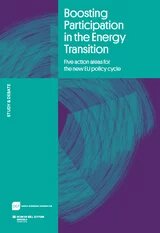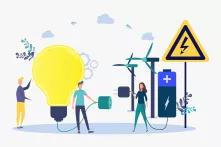
35 to 72 million people across the EU are facing energy poverty. These issues already have powerful implications today from a public health or productivity point of view. Over the years, the EU has constructed a series of policy instruments to assess better and comprehensively address the phenomenon.

According to the European Commission (EC), between 8% and 16% of the EU population faces energy poverty (35 to 72 million people). These issues already have powerful implications today from a public health, social cohesion, or productivity point of view. In the meantime, heat waves, floods, and fires show us that the most socially fragile elements of our societies are the first affected by climate warming (IPCC, 2022). At the same time, the EU lacks a framework for assessing the summertime dimension of energy poverty. Moreover, not all EU countries face the same level of energy poverty, and the assessment depends on the indicators used. For example, the map below shows that more than 20% of the population cannot adequately heat one’s home in Portugal, Bulgaria, Greece, and Lithuania. This contrasts with the situation visible in Sweden or the Netherlands, where the number of households identified is much smaller. How can these differences be explained? How can Europe find consistent solutions and responses among countries with such different backgrounds?
Source: European Commission Joint Research Centre 2024
Historical background
Once overlooked, energy poverty has become a central focus of the European political agenda. The EC, under pressure from researchers and civil society, began addressing this issue over the past decade. The consensus on its importance grew around 2015-2018 with discussions on the Energy Union, a strategy for affordable, secure, and sustainable energy (Bouzarovski, Thomson, and Cornelis 2021).
The Energy Union has modernised the EU's regulatory framework for CO2 emissions, renewables, and consumer protection. In parallel, the EU launched the first observatory dedicated to energy poverty alongside various pilot projects. Energy poverty is now understood as the inability to afford basic energy needs due to high costs, low income, and inefficient housing. The Energy Union’s legislative package, ‘Clean Energy for All’, finalised in 2019, required EU Member States to monitor energy poverty levels and implement targeted measures like retrofitting programmes or special tariffs for vulnerable consumers. While some countries, such as France, had initiatives like their Observatory for Energy Poverty, launched in 2010 (Cornelis 2021); for others, this approach was new. These nations previously viewed energy poverty as a marginal issue unrelated to energy policy or housing markets. The ‘Clean Energy for All’ package now provides the EU with tools to monitor national policies and set targets to reduce energy poverty (Bouzarovski et al. 2020).
Changes since 2019
In 2019, the EC decided to go further and proposed a Green Deal to make the economy resilient towards environmental and social emergencies. In the meantime, the Yellow Vests crisis hit France, which showed that the ecological transition could not be done without the support of the people. In the spring of 2020, as the world was hit hard by the COVID-2019 pandemic, the EC saw a unique opportunity to focus its economic recovery programme on transforming its economy around green and sustainable development and meeting the needs of its comparatively wealthy yet ageing population. In the following years, Russia’s instrumentalisation of gas prices as a war tool exposed EU households to extreme price hikes from wholesale electricity markets and exposed Europe’s dependency on fossil gas.
Hence, instead of addressing energy poverty in opposition to the ecological transformation of our economies, the Commission built the idea of a genuine and inclusive ‘just transition’ that heals the planet and the people while ensuring security and independence. It should be done through structural solutions: higher paying jobs, quality housing, consuming less energy that is also decarbonised, more affordable utility bills, and greater physical comfort. The EU aims to become the undisputed leader in addressing climate change while preserving the well-being of its population.
The EU set up binding long-term climate objectives (cut net greenhouse gas emissions by at least 55% by 2030 and climate neutrality by 2050) through its first-ever European Climate Law in the spring of 2021. Europe must prioritise energy efficiency to reduce its energy and carbon footprint, particularly in the building and housing sectors, which are also essential social imperatives. Buildings are responsible for over a third of CO2 emissions and 40% of the EU’s energy consumption. Apart from 85% of the EU’s building stock, which was built before 2001, most buildings will still stand in 2050. However, the quality of buildings is decaying: the current retrofit level is lagging at 1% per year. Hence, the EU has been seeking to stimulate the Member States’ commitment and participation and put in place a series of measures to bring the performance levels of the South closer to those of Northern Europe.
Since the fall of 2020, the EC has issued a Communication on the Renovation Wave and Recommendations for Member States on addressing energy poverty. These documents aim to boost a reliable and consistent commitment from all stakeholders, starting with national political forces, energy and construction companies, banks, and (social) organisations working on the land.
Energy poverty in the ‘Fit for 55’ package
The EU has built policy and budget instruments to boost its climate policy and help the most vulnerable households, the ’Fit for 55’ package. This series of directives and regulations includes measures that seek to reach out and cut out expenses for vulnerable and energy-poor households, particularly the revisions of the Energy Efficiency (EED) and the Energy Performance of Building (EPBD) Directives. There is also the first (incomplete) official definition of energy poverty: “‘energy poverty’ means a household’s lack of access to essential energy services, where such services provide basic levels and decent standards of living and health, including adequate heating, hot water, cooling, lighting, and energy to power appliances, in the relevant national context, existing national social policy and other relevant national policies, caused by a combination of factors, including at least non-affordability, insufficient disposable income, high energy expenditure and poor energy efficiency of homes” (Article 2 (52). The EU also wants to broaden the understanding of vulnerability to be more inclusive of systemic discrimination (such as “sex, gender, age, disability, race or ethnic origin, sexual orientation, religion or belief”).
The Social Climate Fund
The EC also proposes to dedicate part of the funds from its emission trading system (ETS) collected from the extra funds of the building and transport sectors to be spent on energy efficiency actions for households in difficult situations into a Social Climate Fund (SCF).
With funding sourced from 25% of ETS revenues—projected to total €72.2 billion from 2025 to 2032 and potentially reaching €144.4 billion when matched by Member States—the SCF aims to ease financial burdens, promote sustainable mobility and housing, and support structural changes that reduce reliance on fossil fuels. Set to take effect in June 2024, with Member States required to submit Social Climate Plans by mid-2025, the fund represents a critical step toward a just and inclusive energy transition. However, the Social Climate Fund has already raised the wrath of energy poverty organisations, decrying the amount of the fund as too low compared to the distributional effect that the expansion of the ETS could have on the most vulnerable populations. Effective and consistent implementation and thorough public consultation are critical to building the structural solutions that ensure a socially equitable transition (Sunderland, 2024).
The outlooks
Overall, political discussions will continue to be challenging because energy poverty goes beyond the traditional prerogatives of the European Union. Energy poverty directly affects the social sphere and the Member States’ social policies. Poverty and inequality have increased with the COVID-19 pandemic and the cost of living crisis, while global warming has not slowed down.
The stakes are high – and the EU has demonstrated important leadership. Notably, even competitiveness-focused frameworks like the Draghi Report on the future of European competitiveness (2024), underscore the urgency of tackling energy poverty. The report highlights that to maintain European competitiveness, it is essential to provide targeted support to low-income households, invest in energy efficiency, and reduce final energy costs.
The recent appointment of a Housing and Energy Commissioner marks a significant step, as it ties the two policy dimensions together. Still, the approach must extend beyond winter heating needs to address energy poverty during summer—a season increasingly critical with rising temperatures.
All this reflects a growing acknowledgement that energy poverty intersects with issues of health, social equity, and resource access, especially for marginalised communities. Broader, more nuanced action and coordination are essential to combat European energy poverty effectively. Recognising these complexities and implementing comprehensive, year-round solutions is key to ensuring an equitable energy transition. This requires meaningful public consultations, intersectional research, and tailored policies to address the varied realities of vulnerable populations across different seasons and regions.
The views and opinions in this article do not necessarily reflect those of the Heinrich-Böll-Stiftung European Union.
This article first appeared on il.boell.org and was updated in November 2024.


